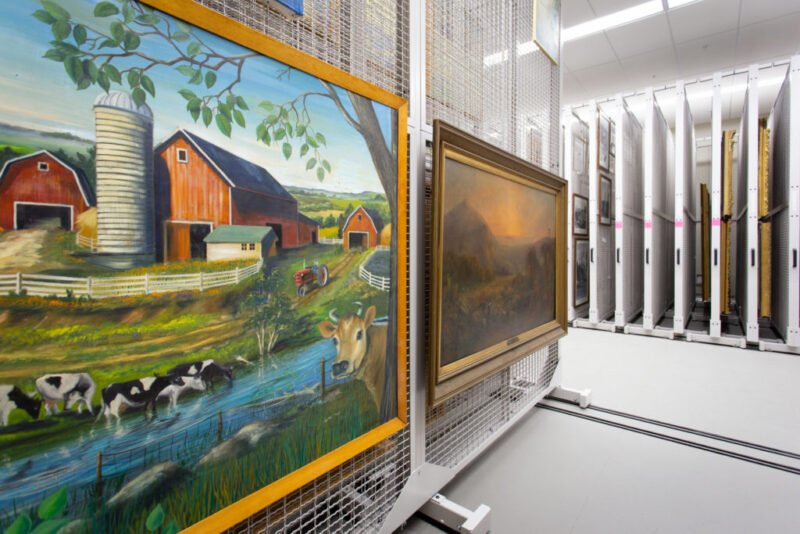Welcome to our comprehensive guide on properly storing your art. As art enthusiasts or collectors, understanding the importance of maintaining it correctly is vital. It is not just an aesthetic addition to our spaces but also a valuable asset that requires careful preservation. Inadequate storage can lead to irreparable damage, diminishing both the beauty and value of your pieces.
In this guide, we will delve into various aspects of storage, from understanding the specific needs of different art forms to creating the ideal environment for preservation. Our goal is to equip you with the knowledge and tools necessary to ensure that your art withstands the test of time. Whether you’re a seasoned collector or a new owner, this guide will provide you with practical insights into the world of art preservation.
Understanding Your Artwork

Understanding the unique characteristics of your artwork is the first critical step in ensuring its longevity. Different types, whether oil paintings, watercolors, prints, or even your kid’s creative works, have distinct needs. For instance, oil paintings require a well-ventilated area to prevent the oil from becoming too dry, while watercolors are best kept away from moisture to avoid smudging. The age and condition of your pieces also play a significant role in deciding the preservation method. Older pieces might be more fragile and susceptible to environmental factors. Additionally, the materials used in the artwork, such as canvas, paper, wood, or metal, dictate the care it needs. A thorough assessment of these factors will help you tailor your storage solutions, ensuring each piece is kept under conditions that best suit its preservation.
Caption: An oil painting needs to be kept in a well-ventilated area, so the oil doesn’t dry out. Alt text: An oil painting with yellow, orange and brown colors
Creating the Right Environment
The environment in which you keep your art is as crucial as the work itself. Ideally, it should be kept in a climate-controlled space where temperature and humidity levels are kept stable. Fluctuations in these conditions can cause materials to expand and contract, leading to damage. The ideal temperature for art storage is around 70°F (21°C), with a relative humidity of about 50%. It is also vital to protect it from environmental hazards such as direct sunlight, which can cause fading, and pollutants like smoke or dust that can adhere to surfaces and cause deterioration. In addition, be mindful of pests, which can be a significant threat, especially to organic materials like paper or wood. By creating a stable and controlled environment, you significantly reduce the risk of damage and ensure the longevity of your collection .
Handling and Preparing Pieces for Storage

Handling and preparing your art for storage is a delicate process that requires attention and care. Always handle it with clean hands or, better yet, with gloves to prevent oils and dirt from transferring. When moving paintings, grasp them by the frame, not the canvas. For sculptures and other three-dimensional works, ensure even support and avoid pressure points that can cause stress or breakage. When preparing your art for storage, use archival-quality materials. Acid-free paper, for instance, is essential for wrapping or interleaving. It prevents chemical interactions that can cause deterioration. Bubble wrap can protect against physical damage but should not be in direct contact with the art surface. For long-term storage, consider using custom-made crates that provide both protection and ease of transport. These steps are vital in preserving the integrity and value of your collection.
Caption: Bubble wrap can be very useful when storing your art as it protects from physical damage. Alt text: Woman sitting on the floor and holding some bubble wrap
Choosing the Right Solutions for Storing Your Art
Choosing the right storage solution is a balancing act between practicality, cost, and the specific needs of your artwork. For many, home storage in a climate-controlled room or closet suffices. However, larger collections or more sensitive works might require professional facilities offering enhanced security. For instance, in urban areas like New York where space is a premium, a company like nycministorage.
Caption: When you have larger pieces or collections, then renting a spacious storage unit is the best choice. Alt text: Three blue numbered storage unit doors
Long-Term Care and Maintenance

The long-term care and maintenance of your art are as important as the initial storage process. Regularly inspect your stored artworks for signs of damage, such as mold, fading, or deterioration. This is especially important in fluctuating climates where environmental conditions can change rapidly. If you notice any issues, address them promptly to prevent further damage. In some cases, this may involve seeking professional conservation assistance. Remember, preventive care is often simpler and more cost-effective than restoration. Alongside physical checks, maintaining accurate records of your collection’s condition and any conservation efforts is essential. This not only helps in managing your collection but also in insuring and valuing your art.
Additional Tips and Tricks
In addition to the fundamental aspects of storing your art, there are several tips and tricks that can enhance your storage solutions. DIY solutions can be both effective and economical. For instance, using acid-free boxes for prints or custom-built racks for canvases can be a practical approach for home storage. Embracing technology can also play a crucial role. Digital hygrometers can help monitor the environment, ensuring optimal conditions are maintained. Moreover, take inspiration from how museums and galleries maintain their collections. They employ best practices in art storage, such as using archival-quality materials and maintaining rigorous environmental controls. These practices can be adapted to personal collections of any size.
Conclusion
In conclusion, storing your art properly is an essential aspect of ownership and preservation. By following the guidelines outlined in this guide, you can ensure that your pieces remain in pristine condition for future generations to enjoy. Proper storage not only protects the physical state of your pieces but also helps in maintaining its creative and monetary value. So whether you are a pro artist or just do simple art projects for fun, we encourage you to share your experiences and insights in preserving art. Your contributions can help build a community of informed art enthusiasts committed to the preservation of their collections.







